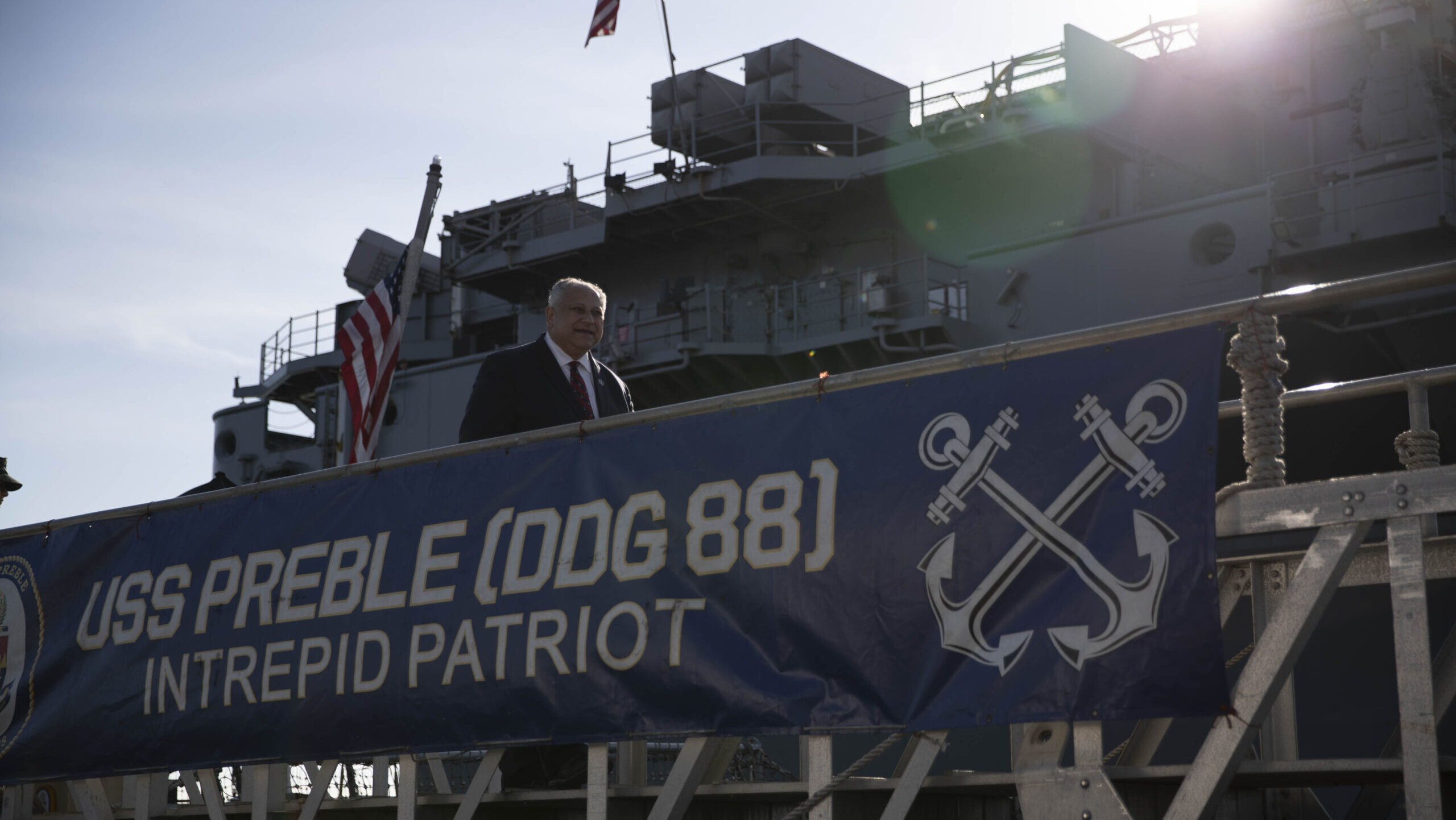
Secretary of the Navy Carlos Del Toro, crosses the walkway of guided-missile destroyer USS Preble (DDG 88) following a tour of the ship, Feb. 16. (U.S. Navy photo by Mass Communication Specialist 2nd Class Olivia Rucker)
WASHINGTON — The Navy today released a rare public accounting of major delays for key shipbuilding programs, with ships from nine programs running behind, in some cases up to three years.
In total, the Navy forecasts a cumulative delay of more than 11 years, at a time when lawmakers and Pentagon planners agree that the Navy needs to be modernizing and growing for a potential conflict in the Pacific.
Among the notable delays as outlined by the report:
- The first Columbia-class submarine, built jointly by General Dynamics Electric Boat and HII, is projected to be between 12 and 16 months late.
- The fourth and fifth blocks of the Virginia-class submarine, also by Electric Boat and HII, are 36 and 24 months late.
- The first Constellation-class frigate from Fincantieri Marinette Marine is 36 months behind schedule.
- The future aircraft carrier Enterprise (CVN-80), built by HII, is approximately 18 to 26 months late.
These kinds of delays for capital warships are broadly tracked by outside observers using budget justification documents and scattered public statements from program officials. But the sort of wholesale confirmation the Navy is now publicizing about the schedule problems facing its most important — and most expensive — programs is a rarity.
“When [Vice Adm. James Downey] and I started this review, we were looking at it from an internal [perspective]: What we were doing and how we were doing it. We weren’t just looking at industry, we were also looking internally [at] how we were doing our business, how we were managing our relationships with our partners,” Nickolas Guertin, the Navy’s senior acquisition executive, told reporters at the Pentagon today.
“We found that we have issues that need to be resolved as well,” he continued. “But we don’t have all those things completely nailed down yet. We don’t have detailed plans of action, milestones, initiatives – we are identifying and deeply looking into where we are now in a ‘get real, get better’ approach.”
The 45-day review had been ordered by Navy Secretary Carlos Del Toro and announced in January. At the time, Del Toro gave few details of the new review’s purpose except to note his concern about problems impacting the Columbia-class submarine and Constellation-class frigates programs.
The new document states that “the purpose of the review is to provide an assessment of national and local causes of shipbuilding challenges, as well as recommend actions for achieving a healthier US shipbuilding industrial base that provides combat capabilities that our warfighters need, on a schedule that is relevant.”
Notably, the document also includes the names of the prime contractors for each ship class it examined. While that information may not be coveted or secret, the veritable poke in industry’s eyes for their programs’ slip ups align with a series of jabs Del Toro has taken at the defense industrial base in recent months.
A spokeswoman for General Dynamics Electric Boat declined to comment. Other shipbuilders named did not immediately respond to a request for comment.
RELATED: In Stark Warning, Navy Secretary Tells Industry To Deliver, Not ‘Goose Your Stock Prices’
While the above ships had delays spelled out, the review was unclear for what is facing other ships surveyed. For instance, the new ocean surveillance ships, a class known as T-AGOS and built by Austal USA, are listed among the other programs assessed, but no schedule delay is provided. Rather, the document states “[To be determined] — based on a new program start.”
Lastly, the review groups together amphibious ship programs, the fleet oilers and the Arleigh Burke-class destroyers as all having “delivery dates late to contract however [are] stable and tracking to program manager estimates.” The amphibious ships, as well as certain destroyers, are produced by HII, while the fleet oilers and destroyers are made by General Dynamics NASSCO and Bath Iron Works.
A ‘Different’ Supply Chain
Although the country as a whole has largely moved on from the worst of the coronavirus pandemic, both the Navy and industry have often talked about the lingering effects it had on the industrial base and underlying supply chain.
Downey, the commander of Naval Sea Systems Command, the Navy’s primary agency for buying and constructing new ships, told reporters today that workforce attrition has continued “in the negative direction in multiple regions. In some places, it’s doubled from where it was at the beginning of the pandemic. In other cases, it’s more than that.”
“The supply chain is different now,” Guertin added. “We need to think longer term when it comes to buying materials further ahead than we’ve traditionally done in the past. And that’s just the world we live in today. So there [are] some differences that we found that we need to dial into how we do this work going forward.”
How the Navy moves forward with the results of the review in hand is less clear based solely on the document.
Under a brief section described as “initiatives to improve,” the document indicates the Navy will “generate a plan to address atrophy in national design and engineering workforce, refine acquisition and contract strategies, reimagine shipyard and skilled labor as a national asset, assess Navy workforce posture [and] budget for investments to improve performance and minimize delays.”
When the Pentagon concludes studies, it will routinely cite the coming budget cycle as the next opportunity where its findings can “inform” future decisions. When asked about what impact this review would have given the fiscal year 2025 budget is already published, Guertin emphasized the initiatives the Navy is targeting don’t require changes to the budget request.
“As you look through these, you might say, there’s not a whole lot of new money in these things. These are just what we do on the government side, to contract smarter, to oversee better, to engage with our industry partners more coherently, and get a better handle on our business,” said Guertin. “So, I think there’s lots of work to do here that doesn’t actually require new money.”
Updated 4/2/2024 at 6:45 PM et with comments from the Navy officials.























